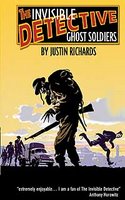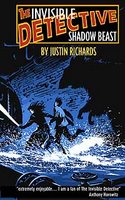

Are they traditional 1930's English mysteries?
Are they creature features?
Are they time travel stories?
The Invisible Detective books by Justin Richards include all those scenarios. At least the two I've read did. They are incredibly multi-layered and enjoyable to an experienced reader who recognizes what's going on. And this experienced reader still hasn't read the first book in the series, so I'm at a bit of a disadvantage. Ghost Soldiers is the the third book, and then I went back to the second because that's how I happened to stumble upon them at I'm a Reading Fool's library.
Our basic premise involves four kids in 1930's London who have set up this imaginary detective, Brandon Lake, who holds court above a locksmith's shop. People come to the so-called Invisible Detective with their problems, though he sits with his back to the room so no one knows that the deep-voiced man in the big chair is actually a boy named Art Drake who's maybe thirteen or fourteen years old. Since I missed that first book, I don't know how they managed to get this started. But people who speak with Art leave him a little money, which he shares among his Scooby gang, one member of which lives on the street.
So here you have your 1930's British detective set-up. To make it a little more palatable to twenty-first century child readers who may not be into that kind of thing, the Scoobies all have what might be described as very modest "super" powers. Meg can tell when people are lying. Jonny is the fastest boy in London. And Flinch, our street urchin, is some kind of contortionist and can wriggle her way in and out of tight spots.
Art's power? He is a leader. What's more, the story occasionally shifts to his future as an elderly man with a grandson who is also named Art Drake. And this Art Drake has some kind of psychic connection with the Art Drake his grandfather used to be back in the 1930's when he and his friends fought crime.
What kind of crime did they fight? Creepy sci-fi crime. Giant mutant rats. Super soldiers who have been created by mad scientists.
I think the sci-fi crime storylines were the weakest element in the books I read. A little too over-the-top. I'm a bit mystified with what's going on with the two Art Drakes, too, probably because I haven't read the first book.
These books strength are those four 1930's kids, who stick together and care about each other and are, for the most part, on their own. What becomes of them in the decades after they function as The Invisible Detective? We know Art lives into old age and has a son who becomes a Scotland Yard Detective just as his own father was back in the '30s. But what about the others? Could that strange girl in the young Art's time who knows more than she should about The Invisible Detective of the '30s possibly be descended from Meg? Could that old guy in the shop where young Art found his grandfather's casebook possibly be Jonny? And what was poor, sweet, illiterate Flinch's fate?
There is so much going on in these books that I do have to wonder if some child readers will be able to keep up with everything. This adult reader, though, will pick up the next Invisible Detective novel she happens upon.
Hmmm...Looks like I may have to make a trip downstairs and check out a couple of books!
ReplyDelete(Yes! I'm back!)
I'll have to get these out of the library. I've read Richards' "Time Runners" series (well the first two that have been published) and the Doctor Who books he's written for the BBC, but I've not got as far as picking up this series.
ReplyDelete(I recently attended a panel discussion he did, but alas, he and the other authors involved were only there to talk about DW books as I wanted to talk to him and Stephen Cole about their non-DW books that I've read.)